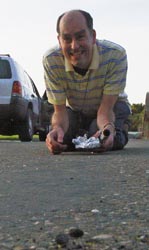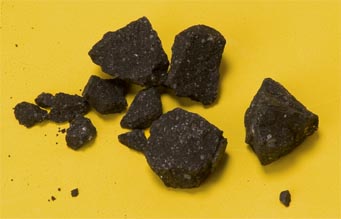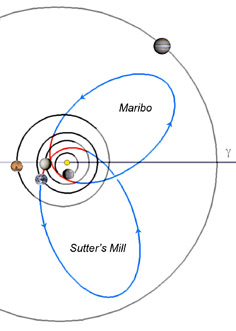Samples of the Sutter's Mill meteorite, found quickly after being dropped by a brilliant daylight fireball, contain pieces of primitive, carbon-rich matter like none ever studied before.

Peter Jenniskens is a cautious, soft-spoken researcher at the NASA-affiliated SETI Institute. But he morphs into an aggressive tiger when it comes to tracking down freshly fallen meteorites. Back in 2008, facing all odds, he spearheaded the effort to recover pieces of a small asteroid that broke apart over northern Sudan.
On April 22nd, luck was on his side when a big cosmic prize fell right into his lap. A dazzling fireball, peaking at magnitude –18 to –20, had streaked east-to-west above Nevada and California at 7:51 a.m. It was widely seen by astonished onlookers — and, more importantly, captured on the cameras of two of them. These records, combined with distinct echoes in Doppler-radar scans, strongly suggested that pieces of the object had fallen to Earth near the towns of Coloma and Lotus, just 120 miles northeast of Jenniskens' office in Mountain View, California.
All the evidence pointed toward a really large arrival — later reconstructions estimate that object was the size of a small car (2½ to 4 m across) and had a mass of perhaps 40 tons before it slammed into the atmosphere. Jenniskens wasted no time, quickly driving to the area in the hope of finding freshly fallen meteorites. He came away empty-handed after searching in a state park but eventually spotted a small 4-g sample — partly crushed from being run over — in a parking lot. By then other searchers were scouring the territory, and in fact professional space-rock hunter Robert Ward found a small fragment before Jenniskens did.

It's now called the Sutter's Mill meteorite, SM for short, named for the area landmark that triggered the 1848 California gold rush. April's interplanetary arrival triggered another gold rush of sorts, as a loosely knit consortium of scientists, meteorite hunters, and local hopefuls repeatedly combed the hilly terrain. At one point Jenniskens and some colleagues even took to the sky in Airship Ventures' Zeppelin to look for small impact craters pocking the Sierra foothills. They didn't find any, but so far collectors have located nearly 80 pieces, with a total mass of just over 2 pounds (943 g).
Critically, the two pieces found on April 24th by Ward and Jenniskens, plus a third spotted that same day by local sleuth Brien Cook, got snatched up before rain soaked the area. This meteorite's dark, crumbly texture was an immediate sign that it's very primitive, a C-class chondrite having fallen to Earth virtually unaltered since its formation 4½ billion years ago — and thus of special interest to planetary scientists. For example, geochemists studying these samples found abundant bits of the mineral oldhamite (calcium sulfide), so touchy that it decomposes after even the slightest exposure to water vapor. Score one for the quick recovery!

P. Jenniskens & others / Scienc
As Jenniskens and 69 coauthors report in Science for December 21st, the Sutter's Mill stones are a mash-up of rocks with varying degrees of exposure to heat and moisture. Planetary scientists term this a breccia, representing pieces of parent bodies with very different origins. "The SM meteorite demonstrates that the complexity of C-class asteroid surfaces is greater than previously assumed," conclude the analysis team. Some pieces have experienced temperatures of up to 400°F (300°C), unlikely to be the result of the flash-heating they got in Earth's atmosphere. Others contain clay and carbonate minerals (from contact with water somewhere in space) and traces of organic compounds.
The printed Science report is only five pages long, but in a 72-page supplement, the Jenniskens-led team details how they pieced together eyewitness reports, photographs, and radar signatures to deduce the incoming object's trajectory and orbit. It came from the asteroid belt, most likely injected directly onto an Earth-crossing path by Jupiter (evidence suggests that it had been exposed to space radiation for less than 100,000 years). Then it slammed into our atmosphere at 17.8 miles (28.6 km) per second, delivering the kinetic-energy equivalent of 4,000 tons of TNT before breaking apart at roughly 34 miles (55 km) up.
To learn more about these celebrated space rocks, see the press releases from NASA and the SETI Institute, or check out Jenniskens' web page dedicated to the impact and recovery. Also worthwhile is a 40-minute Google+ interview moderated by science writer Alex Witze.
 4
4
Comments
Anthony Barreiro
December 28, 2012 at 1:31 pm
Peter Jenniskens gave a very interesting lecture at our monthly San Francisco Amateur Astronomers meeting on December 19. The Science article about the Sutters Mill meteorite was embargoed awaiting publication, so he couldn't talk about the Sutters Mill meteor. Instead he talked about the large fireball meteor that passed over the San Francisco bay area on the night of October 17. Jenniskens led a team that recovered fragments of this meteorite as well. It just so happened that the meteor passed over during our SFAA meeting and lecture, so we were all inside the auditorium at the Randall Museum and missed the show! Jenniskens teased us mercilessly about that.
Jenniskens told us how to identify and pick up meteors. Don't use a magnet to identify ferrous meteorites, as the magnet will erase the valuable magnetic signature the meteorite brought to Earth. And the best thing for picking up meteorites is aluminum foil. Latex gloves will introduce organic contaminants.
Jenniskens does have an eery passion about meteorites. One fragment of the October 17 meteorite bounced off the roof of a house in Novato. Jenniskens told their next door neighbors, who helped find the fragment, that it would have been much better if the meteorite had gone through the roof, as that would have made positive identification much easier and quicker!
You must be logged in to post a comment.
John Wharton
December 31, 2012 at 7:31 am
Interesting article (and good recovery tips from Anthony B.'s follow-up comment). One reference in the story is a bit confusing - if this carbonaceous chondrite is a virtually unaltered sample of the solar system's formation 4.5 billion years ago, it's assumed that it wasn't ejected from a parent body. Yet the article goes on to say that it was "exposed to space radiation for less than 100,000 years." So where would it have been the rest of the time that kept it from being bombarded by cosmic, solar, and even Jovian radiation?
You must be logged in to post a comment.
Rod
January 1, 2013 at 10:58 am
John Wharton's question points to an issue concerning meteorite ages assigned. Here we see the problem of reconciling differences in radiometric ages of meteorites and the CRE ages let alone problems with discrepant radiometric dates.
Q: How do we factually know that this meteorite or any other orbited the Sun for 4.5 billion years?
You must be logged in to post a comment.
Kelly Beatty
January 2, 2013 at 1:28 pm
John (and Rod): radiometric age (when something solidified) is not the same as cosmic-ray-exposure age (how long a rocky object has been exposed to space). it only takes a couple meters of overlying material to effectively shield an object from cosmic rays. so, in this case, the Sutter's Mill stones must have fragmented off a somewhat larger object. Jenniskens and his team speculate that both SM and Maribo could have come from a breakup involving asteroid 495 Eulalia. you can read a bit more about this idea here: http://is.gd/62Vu5g
You must be logged in to post a comment.
You must be logged in to post a comment.